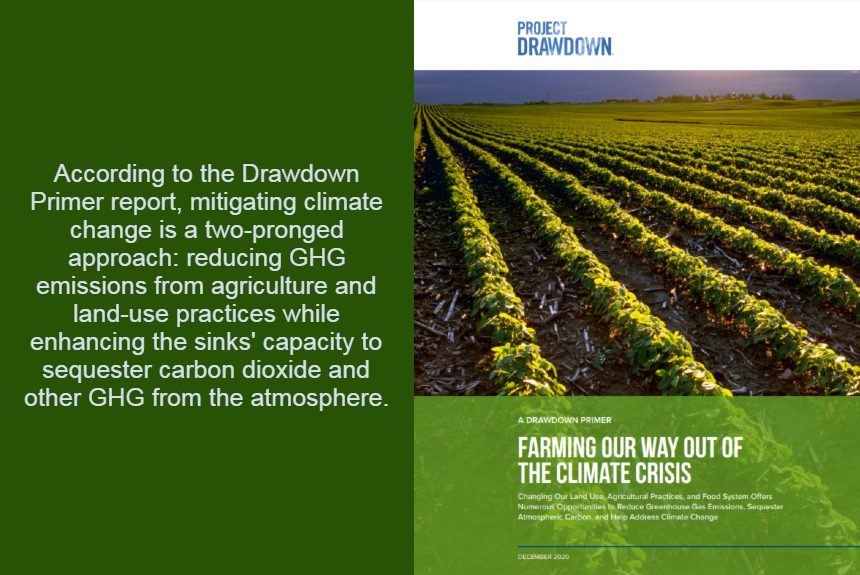Burning enormous amounts of fossil fuels since the Industrial Revolution has caused climate change. The increasing concentration of carbon dioxide in our atmosphere is causing the planet to heat up.
However, climate change is not only caused by carbon dioxide. Other greenhouse gases (GHG), like methane and nitrous oxide, are emitted through other human activities, such as farming and ploughing practices, manufacturing cement and steel, degradation of our forests and ecosystems, cattle and rice farming, landfills, and our use of refrigerants and fertilisers. These GHGs not only trap heat but also pollute our environment.
According to the Project Drawdown primer report, around 59% of carbon dioxide and other greenhouse gases like methane and nitrous oxide stay in the atmosphere. In comparison, roughly 41% of emissions are absorbed by land and the ocean.
Project drawdown focuses on the massive potential that our natural sinks, like agricultural lands, grazing fields, oceans, wetlands, and forests, absorb enough GHG to cause atmospheric levels to begin to drop. Hence, the drawdown is a critical turning point that could stop climate change.
Food, agriculture, and land use account for almost a quarter of global emissions. However, changing farming, tilling, food production, and tilling practices and systems present a significant opportunity to capture carbon and other atmospheric GHGs, thus reversing climate change.
According to the Drawdown Primer, mitigating climate change is a two-pronged approach: reducing GHG emissions from agriculture and land-use practices while enhancing the sinks’ capacity to sequester carbon dioxide and other GHG from the atmosphere.
Croplands and pasturelands cover between 35% and 40% of the earth’s ice-free area, and we should use these as GHG sinks.
How do carbon and GHG sink work?
Carbon dioxide is removed from the atmosphere by being absorbed through photosynthesis. Later, CO2 is stored in vegetation like grass and trees. Carbon dioxide also seeps into the plants’ roots and is stored as organic matter in the soil.
This process removes carbon dioxide from the atmosphere, which is stored in the ground and biomass for many years up to several centuries. However, the carbon locked up in the biomass and soil can still be released through decomposition and microbial respiration.
Nature is already doing this process without our help, but what if we helped nature enhance or maximise its capacity to sequester carbon so that we could remove more carbon dioxide from the atmosphere?
According to the report, there are many ways to do this, and one of them is through “regenerative agriculture”, – which refers to a change in farming and land-use practices to create new carbon sinks.
The report describes farming practices that sequester carbon, including “regenerative agriculture,” an annual cropping technique that allows croplands to accumulate biomass, increase plant cover, and rebuild the soil.
According to the report, regenerative agriculture “aims beyond maintaining the landscape’s ecological health and soil fertility to actively restoring and improving soil fertility and ecosystem health. Such farming practices start accumulating significant amounts of organic matter, rebuilding the soil, and sequestering carbon from the atmosphere. On croplands, these practices include no-till cultivation (which, unfortunately, is often linked to heavy herbicide application), cover cropping, compost application, and other practices from the organic and sustainable agriculture pantheon.”
Other farming practices mentioned in the report include restoring forests and planting large areas of trees, perennials agriculture through increased adoption of agroforestry systems and perennial crops, and managing grazing lands with “regenerative agriculture” techniques, so they accumulate soil carbon.
The report also discusses in detail important related topics on carbon, including where carbon is stored in a working landscape and the process of soil carbon accumulation, the detailed breakdown of GHG from agriculture, the capacity of soil to act as methane sinks, how much carbon can agriculture lands sequester and for how long, and other topics.
In conclusion, the report emphasised that solving the climate crisis involves two critical solutions: reducing emissions from the food, agriculture, and land use (FALU) sector and enhancing the carbon sequestration capacity of agricultural and farming lands.
It is also crucial that carbon sinks are managed well into the future to avoid releasing sequestered carbon back into the atmosphere. Additionally, the report endorses a portfolio of climate solutions, including reducing food waste, changing diets, and creating healthier landscapes and waterways, highlighting that every climate adaptation and mitigation approach is worth pursuing.
To read the entire report, click the link below:
Click on the button below to learn more about Project Drawdown.
Source:
Farming Our Way Out of The Climate Crises. Changing our Land Use, Agricultural Practices, and Food System Offers Numerous Opportunities to Reduce Greenhouse Gas Emissions, Sequester Atmospheric Carbon, and Help Address Climate Change. (2020 December). Project Drawdown. Retrieved from https://drawdown.org/sites/default/files/pdfs/DrawdownPrimer_FoodAgLandUse_Dec2020_01c.pdf



Leave a Reply